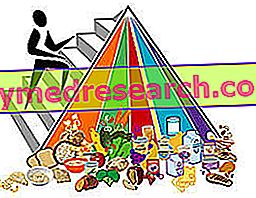Edited by Massimiliano Ratta
Classification of Nutrients
A nutrient is an essential substance for the body to maintain life, its growth and the renewal of its structures.
We can distinguish the nutrient family in two main groups:
Macronutrients and micronutrients .
The former are those that are supplied to the body in greater quantities, while the latter are introduced in small quantities.
Macronutrients are divided into carbohydrates, proteins, fats, fibers and water.
Micronutrients are divided into vitamins and minerals.
In each food some dozens of nutrients may be present in varying proportions; therefore, it is useful to remember that in a balanced diet it is necessary to take into account not only the number of calories contained in a food, but above all the presence of the nutrients that we find in the latter.

Below is a description of the macro and micro nutrients and the functions they perform.
See also: Caloric subdivisions and nutrient percentage
Carbohydrates or carbohydrates
They are used by the body as an energy fuel, they develop about 4 kcal per gram and we find them mainly in starches, in cereals, in bread, in legumes, in fruits, in potatoes, in honey, in flour, in dried fruit and in jams. They are divided into two main categories:
1- sugars or simple carbohydrates (monosaccharides and disaccharides)
2- starches or complex carbohydrates (oligosaccharides and polysaccharides)
Simple carbohydrates are composed of an elementary sugar molecule, from which the term monosaccharides, or the bond of two monosaccharides, which gives them the term disaccharides .
They are simple carbohydrates, for example: fructose, glucose and galactose (monosaccharides), but also sucrose, lactose and maltose (disaccharides) .
Carbohydrates composed of a union of 3 - 10 units of simple sugars are called oligosaccharides . The most complex carbohydrates, those composed of a high number of monosaccharide units, which can be several thousand, are called polysaccharides .
They are complex carbohydrates, belonging to the group of oligosaccharides :
- maltodextrins, which are made up of short chains of glucose molecules, which makes them easily digestible but not as fast as simple sugars; thanks to this feature, maltodextrins ensure a slow and long-lasting release of energy, and are therefore very suitable as a supplement to be taken during training;
- fructo-oligosaccharides (FOS) and galactol oligosaccharides (GOS), which are composed of fructose and galactose molecules; not being completely digestible, these nutrients reach the end of the intestine intact (colon), where they are useful for the selection of beneficial bacteria useful to the body.
Instead we find polysaccharides in starchy foods (cereals, potatoes and many other types of vegetables).
Both carbohydrates ( simple and complex sugars ) supply the body with energy but, while the former tend to create sudden fluctuations in the level of glucose in the blood (glycaemia) - with the effect of raising the energy levels considerably for a period of limited time, but then drastically lowering them - complex carbohydrates (molecules composed of chained sequences of simple sugars), during the digestive processes are demolished into simple units in order to be absorbed. Thanks to this mechanism, complex carbohydrates supply energy more slowly, but for longer periods, avoiding the aforementioned fluctuations in blood sugar.
Carbohydrates generally represent the largest portion of the food ration, varying on average from 50% to 80% of the daily total, based on individual needs and requirements.
2) Proteins and amino acids
From the Greek "PROTEIOS" (primary).
They are organic substances consisting of four main elements: Carbon, nitrogen, oxygen and hydrogen. As with carbohydrates, they bring about 4 kcal per gram and cover a large number of vital functions for the body, such as:
- plastic processes : that is to build all the tissues that are subject to continuous demolition and synthesis, first of all the muscles;
- regulatory processes : as the precursor proteins of hormones, neurotransmitters, enzymes and other molecules of biological importance, regulate their production and functioning in the body;
- energy processes : the body can transform proteins into energy through their cleavage in amino acids and the removal of the nitrogenous part, giving rise to their conversion into glucose (see glucogenic amino acids).
Although there are many amino acids present in living organisms, only some of them (about 20) are responsible for the formation of proteins. We can distinguish said amino acids into two main groups: essential and non-essential, even if a minor subgroup, called essential seeds, is added to the latter category.
- Essential amino acids : phenylalanine, isoleucine, lysine, leucine, methionine, threonine, tryptophan and valine; they are so named because they cannot be synthesized by the body, therefore they must appear in sufficient quantities in the daily dietary ration.
- The non-essential : arginine, histidine, alanine, L-aspartic acid, L-glutamic acid, glycine, proline, serine, asparagine, glutamine; if they are not present, they can be synthesized through the transformation of other amino acids.
- The essential seeds : taurine, tyrosine and cysteine; these nutrients can be synthesized by the body from phenylalanine and methionine, provided that these precursor amino acids are supplied appropriately.



